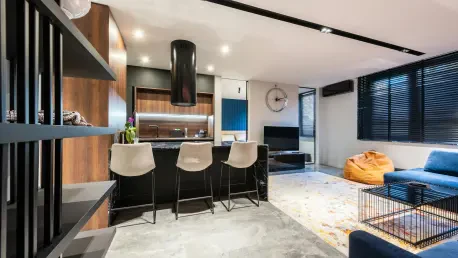In modern kitchen design, the role of color extends far beyond mere aesthetics, serving as a vital tool that shapes the atmosphere and functionality of the space. The choice of paint can dramatically alter the feel of a kitchen, enhancing its visual appeal and usability. Sherwin-Williams, with its diverse palette of paints, has become a favorite among interior designers who aim to create harmonious yet dynamic kitchen environments. Their offerings allow for varied expressions of personal style, whether through bold, statement colors that capture attention or neutral tones that provide a versatile backdrop.
Leveraging Color as a Design Element
Color’s Dual Role in Aesthetics and Functionality
Paint color in kitchen design isn’t just about how a space looks; it is a crucial component of its overall function. Sherwin-Williams paints are selected with a deep understanding of how colors can influence both mood and practical use. The accurate selection of a paint shade can redefine a kitchen, imbuing it with warmth, vibrancy, or calmness, aligning with the desired atmosphere. Interior designers appreciate the broad spectrum of options that Sherwin-Williams offers, enabling them to match the paint precisely to a kitchen’s layout and the client’s lifestyle. This ensures that the kitchen remains as welcoming and comfortable as it is functional.
Designers often begin the process by considering how colors will interact with a kitchen’s lighting. Natural and artificial light can transform a color’s appearance throughout the day, making it essential to choose shades that adapt gracefully. Warm hues might become more intense under sunlight, while cooler colors might appear softer and more subdued in the evening. Sherwin-Williams’ extensive range helps designers select colors that maintain harmony, continually offering a pleasing visual experience. This strategic use of color can help alleviate design challenges, such as making small kitchens feel larger or highlighting specific architectural features to create a focal point.
The Art of Selecting Designer-Preferred Shades
Sherwin-Williams’ acclaim among interior designers stems heavily from its curated collection of shades, each carefully chosen for its versatility and timeless appeal. Designer favorites are often colors that provide a solid foundation while allowing the freedom to incorporate varying design elements. Colors like Accessible Beige and Alabaster are revered for their neutrality, offering an elegant background that supports a wide array of decorative styles. These shades are particularly praised for their ability to stand the test of time, an essential factor in kitchens where frequent redesigns are typically impractical.
Other more daring colors favored by designers, such as Tricorn Black or Naval, bring a distinctive edge to kitchen spaces. These shades are chosen not just for their visual impact but also for their ability to create depth and drama within a space. They encourage creative expression and provide an opportunity to infuse personality into an otherwise functional room. Sherwin-Williams’ paints have been tested in countless real-world settings, proving consistently that they can not only deliver aesthetic value but also uphold their luster and durability over time, even in high-traffic kitchen environments.
Embracing the Interplay of Light and Color
Exploring the Influence of Natural Light
The interaction between paint colors and natural light in a kitchen is pivotal in determining the room’s overall ambiance. Interior designers focus keenly on how Sherwin-Williams colors behave in varying light conditions, which can change the perception of a color significantly. A hue that appears vibrant in abundant daylight may take on a more subdued tone in the evening. Thus, selecting colors that can adapt to different lighting scenarios is critical for maintaining a kitchen’s appeal throughout the day.
Natural light can highlight the subtleties of color undertones, which may otherwise go unnoticed. For instance, a color with a subtle green base might appear fresher and more organic when bathed in natural light. Designers often leverage this by choosing colors that will react favorably to the kitchen’s light conditions, whether it be morning light streaming through east-facing windows or the soft glow of sunset. This strategic selection process ensures a kitchen remains inviting at all hours, crafting a dynamic environment that evolves with the daylight.
Balancing Warm and Cool Undertones
The delicate balance of warmth and coolness in a kitchen’s color scheme impacts not only the aesthetic but also the sensory perception of the space. Sherwin-Williams paints offer a range of shades with varying undertones suited for achieving this balance. Warm colors like warm grays and beiges can bring a sense of coziness and make spaces feel intimate and nurturing. Conversely, cool tones like blues and greens can open up a space, offering an airy, refreshing feel that is particularly beneficial in compact kitchens.
Designers aim to strike the right thermal perception balance by considering factors such as the kitchen’s size, natural light exposure, and the desired mood. In a northern-facing kitchen with less natural light, warmer colors can counteract a potentially cold atmosphere, providing a welcome warmth. Conversely, in brighter kitchens, cooler shades can help moderate the feeling of heat, ensuring comfort even on warmer days. The ability of Sherwin-Williams paints to deliver this nuanced thermal balance underscores their value in creating kitchens that aren’t just beautiful but also comfortable to live in.
Navigating Trends and Timeless Design
Current Trends in Kitchen Colors
The evolving design landscape often poses the challenge of balancing contemporary trends with enduring styles. Sherwin-Williams’ color offerings cater not only to current design currents but also to timeless aesthetics that promise lasting appeal. Trendy shades, such as muted terracottas or organic greens, are celebrated for their ability to reflect modern tastes while promoting sustainability and biophilic design principles. These colors resonate with the current emphasis on eco-friendliness and connection to nature, making them popular choices in cutting-edge kitchen designs.
Despite the allure of current trends, designers also heavily invest in colors that are timeless. Shades like pure whites, earthy neutrals, and deep charcoals offer a classic appeal that seamlessly integrates with both contemporary and traditional styles. These colors maintain relevance by providing a stable background upon which other design elements can evolve. Sherwin-Williams achieves this foresight by ensuring their palette includes a breadth of options that work across progressive and classic design themes, ensuring that kitchens remain stylish and functional regardless of changing design norms.
Personal Expression Through Color Customization
One of the most compelling aspects of selecting kitchen colors is the opportunity for personal expression. Sherwin-Williams paints allow for a high degree of customization, enabling homeowners to incorporate personality and lifestyle into their kitchen design. This choice of color is more than just a visual complement; it is an extension of the individual’s identity. Homing in on colors that resonate with personal preferences, designers craft spaces that feel intimately connected to those who inhabit them.
Whether a homeowner desires a serene retreat with calming blues and greens or wishes to establish a vibrant, energetic cooking space with bold reds and yellows, Sherwin-Williams provides a myriad of options. The customization potential allows for kitchens that reflect personal stories and aesthetic inclinations. By choosing colors that align with personal taste and integrating them thoughtfully with other design elements, designers can transform kitchens into spaces of individuality and inspiration, tailored uniquely to the style and rhythm of life of their occupants.
Conclusion: The Transformative Power of Paint
In contemporary kitchen design, color serves a purpose far beyond its visual appeal, functioning as a crucial element that influences both the ambiance and practicality of the space. The importance of selecting the right paint color cannot be overemphasized, as it has the power to transform the kitchen’s overall vibe, making it more inviting and efficient. Sherwin-Williams stands out in the realm of interior design with its extensive array of paint colors, becoming a preferred choice for many designers aiming to craft kitchens that are both cohesive and vibrant. Their extensive selection allows homeowners and designers alike the freedom to express personal style, whether opting for bold, eye-catching hues that command attention or choosing subdued, neutral shades that offer a flexible backdrop. By employing the rich color offerings from Sherwin-Williams, kitchens can be transformed into spaces that not only reflect personal tastes but also enhance functionality, ensuring the room is both stylish and practical in daily use.









